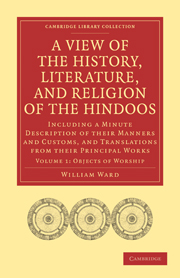 A View of the History, Literature, and Religion of the Hindoos
A View of the History, Literature, and Religion of the Hindoos Published online by Cambridge University Press: 05 October 2010
These beings are either the enemies of the gods, as the ŭsoorŭs and rakshŭsŭs; or their companions; or those who are employed as dancers, singers, or musicians in the heavens of the gods. They are worshipped at the great festivals, but have no separate images.
SECT. I.—The Usoorŭs, or Giants
These enemies of the gods are the offspring of Kŭshyŭpŭ the progenitor of gods, giants, men, serpents, and birds, by his different wives. They bear a resemblance to the titans or giants of the Grecian Mythology; and stories of their wars with the gods (some of which will be found in this work) abound in the pooranŭs. Indrŭ, Vishnoo, Kartikŭ, and Doorga, are distinguished among the Hindoo deities for their conflicts with these beings. King Vŭlee, a giant, is worshipped by the Hindoos on their birth-days, with the same forms as are used in the worship of the gods.
Story of the churning of the sea by the gods and ŭsoorŭs.—
The most rancorous hatred has always existed betwixt the ŭsoorŭs and the gods, although half-brothers; the former having been excluded by the gods from succeeding to the throne of heaven: and dreadful conflicts were carried on betwixt them with various success, till both parties sought to become immortal. The giants performed the most severe religious austerities, addressing their prayers alternately to Vishnoo, Shivŭ, and Brŭmha; but were always unsuccessful.
To save this book to your Kindle, first ensure [email protected] is added to your Approved Personal Document E-mail List under your Personal Document Settings on the Manage Your Content and Devices page of your Amazon account. Then enter the ‘name’ part of your Kindle email address below. Find out more about saving to your Kindle.
Note you can select to save to either the @free.kindle.com or @kindle.com variations. ‘@free.kindle.com’ emails are free but can only be saved to your device when it is connected to wi-fi. ‘@kindle.com’ emails can be delivered even when you are not connected to wi-fi, but note that service fees apply.
Find out more about the Kindle Personal Document Service.
To save content items to your account, please confirm that you agree to abide by our usage policies. If this is the first time you use this feature, you will be asked to authorise Cambridge Core to connect with your account. Find out more about saving content to Dropbox.
To save content items to your account, please confirm that you agree to abide by our usage policies. If this is the first time you use this feature, you will be asked to authorise Cambridge Core to connect with your account. Find out more about saving content to Google Drive.